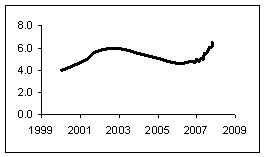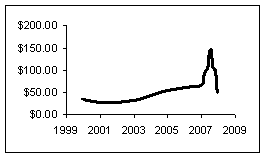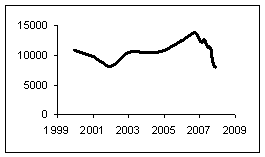I am sure this is a fine CBC journalist and her report about OPEC was interesting, but I do wonder: why did she have a dead Christmas tree (looks like leftover from last year) to her left in the background?
Looks like Stephen Hawking is coming to Waterloo. I may not be an adoring fan, but I am certainly an admirer: being able to overcome such a debilitating disease and live a creative life is no small accomplishment even when you don’t become a world class theoretical physicist in the process.
Are we going to have a coalition government in Canada? Perhaps not, now that the Conservatives backed off on their idea to drop federal financing of political parties. I’d have liked to see a coalition government. Sure, multi-party politics are inherently messier than a neat two-party or one-party system, but so long as we don’t end up like Italy or Israel, the result may very well be a more representative, more responsive government.
Anyhow, you just gotta love Chretien’s “Je ne comprends pas anglais” comment…
Like other software, this Web logging software, WordPress, also needs to be updated from time to time. It appears that my attempt to update it just now to version 2.6.5 was successful.
Watching the pictures from Mumbai, I cannot help but wonder: when WW3 inevitably arrives, will we also be seeing live pictures and breathless news media coverage as major cities around the world turn into radioactive mushroom clouds and millions of lives are reduced to ash and smoke? Will there be a new Wikipedia article about the nuking of London, Paris, and New York City moments after they occurred, just as there is already an extensive article in Wikipedia on the 26 November 2008 Mumbai attacks?
A few hours ago, I became rather alarmed, as suddenly, my outgoing network connection was saturated. “What the…?” asked I, as it took a little bit of frantic searching in the log files before I had my answer: Somehow, my old Web page about the 4-bit processor I built many years ago became rather popular, as apparently, it was featured on reddit.com. Cool! Now if only those visitors actually clicked on the Google ads that I hastily placed on these pages…
This sounds almost like a rallying cry for white supremacists and their crazy claims of reverse discrimination, but did Carleton U. really cancel Shinerama in an act of political correctness gone rampant because supposedly, cystic fibrosis is a “white male’s disease”?
A new paper by Sean Carroll asks this question in its title “What if time really exists?” I feel reassurred that Carroll thinks it does (hmmm, let me check my watch… yup, I think it exists, too) but the fact that a paper with this title appears in an archive of theoretical physics papers perhaps illustrates what is so wrong with physics today. To quote Carroll, “when something is so obvious and important, declaring that it isn’t real is sure to win points for boldness”, but have physicists really become this shallow?
I’m listening to Mitt Romney. He’s not the only one suggesting that the big problem with Detroit is that it is burdened by its unions: that excessive benefits like generous pension plans are the reason why Detroit cannot compete with others, and that the solution is a restructuring that helps the automakers get rid of these undue burdens.
I don’t want to sound like a grumpy socialist (which I am not, or at least I sure hope I am not) but is the rolling back of worker benefits really the right solution in this time of crisis? I am certainly not advocating an isolationist economic policy that protects an inefficient industry from foreign competition, but how about requiring that other automakers who either manufacture cars in, or export cars to, the United States, play by the same rules as the “big three”?
Either Romney is wrong, and the unions can take solace in the fact that a Democratic president with a large Democratic majority in both houses is about to be unaugurated. Or, Romney is right and Obama and the Democrats are about to make some colossal economic mistakes. Time will tell.
I’ve been reading a lot about gauge theories lately. I once wrote what I thought was a fine and concise description of the principle of gauge invariance, but I needed Schrödinger’s equation for it, which made my explanation both non-classical and non-relativistic.
Finally, with the help of a Wikipedia article no less, I think I managed to understand how a gauge theory can come into being without involving any quantum physics. It’s simple, really, surprisingly so.
What you need is a (classical) field theory. A field theory is specified by its Lagrangian, which, crudely speaking, is just the difference between the kinetic and potential energy. For a scalar field φ, the kinetic energy of the field is the square of its gradient, ∂μφ∂μφ. The potential term can be nothing (massless particle in empty space) or it can contain a mass term in the form m2φ2.
Where things begin to get interesting is when we allow φ to be a complex field. In this case, rather than writing φ2, we must now write φφ*, where φ* is the complex conjugate of φ. The same thing happens in the kinetic term. So now the Lagrangian reads,
L = ∂μφ∂μφ* – m2φφ*.
The reason why this is so interesting is that if we change the phase of φ by a set amount (i.e., multiply φ by eiψ) the conjugate’s phase changes by the opposite amount (i.e., φ* it gets multiplied by e–iψ). Their product, therefore, multiplied by eiψe–iψ = 1, remains unchanged. In other words, our Lagrangian is invariant under a global rotation in the complex plane. Right there, this has an important implication: as per Noether’s theorem, a global symmetry implies the existence of a conserved current.
But what if the symmetry is not global but local? Meaning that we rotate φ in the complex plane as before, but the angle of rotation is not the same everywhere? Clearly, φφ* still remains unchaged just as before, but the same is not true for ∂μφ∂μφ*; the derivative operator brings new terms into the Lagrangian.
These new terms are best dealt with by changing the derivative operator into a covariant derivative: ∂μ → Dμ = ∂μ + Aμ, where Aμ is an arbitrary vector field.
Or maybe not so arbitrary. We can make Aμ anything we want, of course, but that also means that we can demand that Aμ satisfy a field equation. Perhaps the field equations of electromagnetism… why not? (After all, every vector field satisfies the field equations of electromagnetism.)
The difference between the original Lagrangian (written using the ordinary derivative ∂μ) and the new Lagrangian (written using the covariant derivative operator Dμ) is the interaction Lagrangian that describes how the φ field interacts with itself through a vector field Aμ. By making the complex φ field locally gauge invariant, we have, in effect, invented the electromagnetic vector potential Aμ.
This is, after all, what gauge theories do: they turn a local symmetry into a force. The local symmetry can be geometric in nature (e.g., a rotation) or it can be an internal symmetry of a field that is not described by simple real numbers. In the present example, the field was made up of complex numbers, and the symmetry was that of the complex plane. This symmetry group is U(1), which is an Abelian group: two rotations in the complex plane, executed one after the other, produce the same result regardless of the order in which they are executed.
In many physically important cases, the symmetry is non-Abelian. The most profound consequence of this is that in place of the gauge field Aμ, which is “inert”, we get gauge field(s) that interact with themselves. In practical terms, when the theory is Abelian, like electromagnetism, the gauge field Aμ represents photons, which are uncharged; but when the theory is non-Abelian, like electroweak theory, the gauge fields are non-Abelian, carry charge, and interact with each other.
The 20th century was the century of weird physics. Weird, mind you, is in the eye of the beholder. Sure, general relativity or quantum mechanics were strange at first, but today, the ideas of invariance, general covariance, or commutator algebras are not at all illogical. More importantly, they work: the predictions of “weird” physics are fully confirmed by experiment.
In contrast, it seems that the physics of the early 21st century is increasingly phantom physics. First, we were told that five sixths if the matter content of the universe is “cold dark matter”, stuff that is invisible and undetectable, as it only interacts with normal matter and with itself gravitationally. Then we were told that all the matter (including dark matter) that is out there is only 30% of the total energy content of the universe, 70% is even more invisible, even more undetectable “dark energy”.
Meanwhile, particle physicists trying to deal with the possibility that the much anticipated Higgs particle will remain undiscovered are toying with the idea that additional particles (which themselves may not be detectable) may cancel out the Higgs boson’s contributions, and thus the Higgs boson would never be detectable. In other words, if I am reading this right, one possibility is that the non-observation of one undetectable particle will be viewed as proof of the existence of another unobserved particle. Wow!
And then I have not even mentioned other undetectable stuff, such as superstrings (too small to ever become detectable by any conceivable experiment), unification (expected to occur at the Planck energy scale, which is forever unreachable by observation), unparticles (yes, there are such animals in the land of theoretical physics), “phantom” matter and energy (I am not making this up), not to mention all the parallel universes of the string theory “landscape”, some of which are populated by “Boltzmann brains” that exist all by themselves, contemplating their existence and inventing imaginary universes around themselves.
I think I prefer the “weird” physics of the 20th century. At least that physics was firmly rooted in what physics is supposedly about, observation and experiment.
New Scientist asked what gifts three time-traveling visitors from the future should bring, if they popped up, say, when the LHC is finally turned on and starts operating. I could not resist the urge to reply. I titled my response “Hope” and wrote:
I would think that three authentic-from-the-future photographs brought by those three visitors would do nicely.
One should bear the image of a happy human in all his imperfect homo sapiens glory, such as a grinning teenager with a pimple on his nose, and no robots, genetically engineered trans-humans, or grey blobs in the background.
The second should show the image of the Earth from space: blue, white, and green in all the right places, pearls of bright cities on the night hemisphere, and nice, not too large, not too small ice caps where those should be.
The third should show another human standing in front of a window on a spaceship. Behind the human, through the window, we see the Milky Way galaxy… from the outside.
Having heard on the news all the phony reasons as to why President-elect Obama must give up his Blackberry, I was planning to write down my strong opinions here. But, it’s no longer necessary… it appears that Newsweek has done it, and I agree with them on all counts: Obama should keep his Blackberry, as it is time for the United States to have a 21st century president.
Wow. It doesn’t happen every day that a cat is found after being lost for 13 years. I hope his owners will be able to nurse him back to health.
I just looked at the channel lineup of Sirius Satellite Radio. They have three classical channels: Opera/Classical Vocals, Classical Pops, and Traditional Classical. 100% Commercial Free, they say.
OK, no commercials. How about commentary? How about radio personalities that inform and entertain, tell you stories about the music you hear?
And narrowly defined as they appear to be, do any of these channels have room for something unexpected? Say, a little Kurt Weill, a little Heitor Villa-Lobos? Astor Piazzolla? A surprise piece of Canadian folk music wedged between two traditional classical pieces, such as Norm Hacking singing about orange cats?
These satellite channels, just like the CBC’s own new Internet channels, seem nothing more than glorified playlists to me. If I wanted a randomized playlist, I have several hundred CDs to choose from… lovely music, all of it, but who will show me something new?
Not the CBC, not anymore. Yesterday, while I was driving somewhere in town, I was listening to CBC Radio 2, as my car radio is still tuned to 103.3 MHz out of habit I guess. What I heard was some hapless, untalented artist’s barely recognizable rendering of an old Abba song. I grieve for a world-class radio station that has been put to premature death by mediocre bureaucrats engaged in cultural vandalism.
In the year 1086, William the Conqueror ordered a survey of England. The result of this became known as the Domesday Book, a detailed account of the material wealth of England on that day of accounting, or reckoning, or doom (dom in Old English), i.e., on domesday.
900 years later, the BBC engaged in a cultural heritage project. The BBC Domesday Project was a multimedia survey of the United Kingdom, published using the latest technology: laser disc. Remember laser discs? Not compact discs, laser discs. 12 inches wide, big, shiny, designed originally to store near broadcast quality analog video.
The two Domesday discs contained professional video segments, numerous photographs encoded as single-frame analog video, along with a large amount of data (including geographic data and data from the 1981 census), as the discs could store about to 300 MB of digital data, a huge data capacity at the time.
All you needed to view the BBC Domesday disc was a specially manufactured laser disc player, along with an Acorn computer with specialized interface hardware.
Of course today it is a tad hard to find a laser disc player of any kind, never mind a specially manufactured model. As to the Acorn with the custom interface and coprocessor, good luck finding one on eBay!
The original creators of the BBC Domesday project knew about possible obsolescence; yet despite their efforts (they sent copies of everything to the UK National Data Archive, where apparently everything promptly disappeared) the data were almost lost.
Although it appears that the BBC Domesday project has been largely rescued, it highlights a bigger problem: what happens to our society’s written record if the medium on which it was written becomes obsolete? Some people speak of the digital dark ages, a period in history (i.e., the present) that will become inaccessible to future researchers, as our collective memory is written in a form that will not be compatible with the hardware of the future. Indeed, to some extent it has already happened… how many people have computers today that can read 5.25″ floppy disks, for instance? Or, what happens to Web sites when the people who maintain them are no longer around? Never mind 900 years, will any of our “domesday books” still be readable just 90 years from now?
There are protests throughout America today in support of same-sex marriage rights. One thing that troubles me is how phony the arguments are on both sides.
Those in favor of same-sex marriage portray it as an equal rights issue. As if gays and lesbians were ever barred from entering into a marriage! Of course they are free to marry… a person of the opposite sex. Broadening the definition of marriage to include same-sex unions is an unprecedented step. That is not to say that it is wrong to take this step, but it’s not quite the same as, say, allowing women to vote.
But those opposed to same-sex marriage have equally phony arguments. They have a right, they say, to the traditional definition of marriage, as if broadening the definition of marriage ever threatened traditional, heterosexual unions. They are worried that pastors and ministers will be forced to marry homosexual couples, not that there is a precedent of a pastor or minister ever having been forced to marry anybody.
Why can we not have a reasoned discussion instead? The argument in favor of same-sex marriage is strong. It is about the rights of two people to care for each other, to be able to act as legal guardians of one another, inherit from one another, visit one another in hospital, and so on. Denying a decent, loving couple these rights just because it doesn’t agree with our idea of a “marriage” just doesn’t sound right.
On the other hand… is it really necessary to provocatively call this “marriage”? I don’t mind it, but many do. If it is indeed about rights and not the symbolism of the word itself, what’s wrong with same-sex unions?
On the third hand… if we recognize marriage as a relationship that legalizes the love and care people feel for one another (as opposed to the potential to procreate), why would we artificially limit it to two people? What is wrong with legalizing polygamy?
On the fourth hand… if, as opponents of same-sex marriage say, marriage is indeed about procreation, what about childless heterosexual couples? Should older or infertile people be allowed to marry?
I believe these are valid questions for a reasoned discussion. Unfortunately, neither plebiscites aimed at changing a state’s constitution to deny a hard-earned right, nor street protests with empty slogans lead to reasoned discussion.
It is always creepy when fact meets fiction. I’ve been watching the latest episode of Terminator: The Sarah Connor Chronicles, which is a surprisingly good quality sci-fi series. I then checked on Google News if there are any news about the show’s rating or popularity. Instead, what I found was a story about a robot in Japan, greeting amusement park visitors, selling tickets, and using face recognition software to profile customers. Not only does it sound a little like Westworld, one commenter actually suggested that it might be time to call Sarah Connor to finish this one off, which is why Google News found this entry in response to my search.
Many textbooks and many popular science books tell you that the event horizon, the so-called “point of no return” in the vicinity of a black hole is nothing special. Apart from increasing (but finite!) tidal forces, an observer would not notice anything special when he crosses the horizon. But is this really true?
If this statement were true, it would mean, in essence, that there is no measurement an observer could perform in his immediately vicinity to determine if his vicinity is at or near the event horizon. But this may not be the case; there may, in fact, be a quantity that is measurable (at least in principle).
The curvature of spacetime is described by the Riemann tensor \(R^{\mu\nu\rho\sigma}\). The gradient (covariant derivative) of this quantity is \(R^{\mu\nu\rho\sigma;\kappa}\). Forming the scalar product of this quantity with itself, we obtain an invariant scalar quantity,
\[ K=R^{\mu\nu\rho\sigma;\kappa}R_{\mu\nu\rho\sigma;\kappa}. \]
If we calculate \(K\) for the Schwarzschild metric of a nonrotating, uncharged black hole, we get
\[ K=720m^2\frac{r-2m}{r^9}. \]
This quantity becomes zero and changes sign at the Schwarzschild horizon \(r=2m\).
So never mind what the books say. In principle, an observer can measure the curvature tensor and its gradient, and therefore, can construct an instrument that measures this invariant \(K\). (Note that although I used the letter \(K\), this is not to be confused with the better known Kretchmann invariant.) If this is true, what other effects might there be that make the event horizon a special place?
There is another thing to think about. Often you hear that the Rindler horizon seen by an accelerating observer, or the cosmological horizon in an expanding universe are “just like” the Schwarzschild horizon (perhaps even suggesting that we might be living inside a black hole.) But this cannot be so! Two observers who are not moving the same way do not see the same Rindler horizon or the same cosmological horizon. These are only apparent horizons, their presence, even their existence dependent on the observer’s motion. In contrast, the Schwarzschild horizon is real: two observers can agree on its location regardless of their own location and motion.



